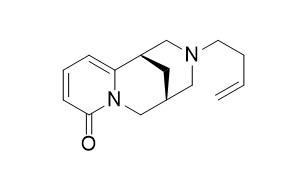Rhombifoline
Reference standards.
Inquire / Order:
manager@chemfaces.com
Technical Inquiries:
service@chemfaces.com
Tel:
+86-27-84237783
Fax:
+86-27-84254680
Address:
1 Building, No. 83, CheCheng Rd., Wuhan Economic and Technological Development Zone, Wuhan, Hubei 430056, PRC
Providing storage is as stated on the product vial and the vial is kept tightly sealed, the product can be stored for up to
24 months(2-8C).
Wherever possible, you should prepare and use solutions on the same day. However, if you need to make up stock solutions in advance, we recommend that you store the solution as aliquots in tightly sealed vials at -20C. Generally, these will be useable for up to two weeks. Before use, and prior to opening the vial we recommend that you allow your product to equilibrate to room temperature for at least 1 hour.
Need more advice on solubility, usage and handling? Please email to: service@chemfaces.com
The packaging of the product may have turned upside down during transportation, resulting in the natural compounds adhering to the neck or cap of the vial. take the vial out of its packaging and gently shake to let the compounds fall to the bottom of the vial. for liquid products, centrifuge at 200-500 RPM to gather the liquid at the bottom of the vial. try to avoid loss or contamination during handling.
Pharmacol Rep.2020, 72(2):472-480.
Antioxidants (Basel).2021, 10(3):379.
J Ethnopharmacol.2017, 198:91-97
Sci Rep.2019, 9:19059
Int J Mol Sci.2024, 25(18):10219.
Compounds.2023, 3(1), 169-179.
Tissue Cell.2022, 78:101901.
Aquaculture2017, 481:94-102
Molecules.2023, 28(8):3414.
Pharmaceuticals (Basel).2024, 17(9):1130.
Related and Featured Products
Phytochemistry. 2006 Sep;67(17):1943-9. Epub 2006 Jul 28.
Chemotaxonomy of Portuguese Ulex: quinolizidine alkaloids as taxonomical markers.[Pubmed:
16876210 ]
Six species of Portuguese Ulex L. in a total of nineteen populations were studied by GC-EIMS as to their content in quinolizidine alkaloids.
METHODS AND RESULTS:
Sparteine, beta-isosparteine, jussiaeiine A, N-methylcytisine, cytisine, 5,6-dehydrolupanine, Rhombifoline, lupanine, jussiaeiine B, N-formylcytisine, N-acetylcytisine, anagyrine, jussiaeiine C, jussiaeiine D, pohakuline, baptifoline, and epibaptifoline were detected. Analysis of the chromatograms showed that the chemical profile of all species was mainly composed of N-methylcytisine, cytisine, anagyrine, and jussiaeiines A, B, C and D. Therefore a quantification study of these alkaloids in all the populations studied was done by GC.
CONCLUSIONS:
These data were then submitted to cluster analysis and principal component analysis, which allowed the definition of five chemotypes and the recognition of hybrids. N-methylcytisine, cytisine, and jussiaeiines A, C and D are recognized as markers of this genus in Portugal.
Arch Pharm Res. 1994 Dec;17(6):393-7.
Rhombifoline and 5,6-dehydrolupanine from Anagyrus foetida L.[Pubmed:
10319146 ]
METHODS AND RESULTS:
Rhombifoline and 5,6-dehydrolupanine were isolated for the first time from the leaves and stems of A. foetida L. indigenous to Saudi Arabia. In addition, five other alkaloids, previously identified in A. foetidia L., namely N-methylcytisine, sparteine, anagyrine, lupanine and cytisine, were isolated. The isolated alkaloids were characterized by UV, 1H-NMR, 13C-NMR and Mass spectral data.
CONCLUSIONS:
13C-NMR data of Rhombifoline and 5,6-dehydrolupanine are reported for the first time.



